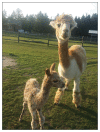Alpaca embryo transfer on a private Canadian farm
- PMID: 29910477
- PMCID: PMC5949955
Alpaca embryo transfer on a private Canadian farm
Abstract
This study evaluated the feasibility of using an embryo transfer protocol in an alpaca farm in Canada. Alpaca donors and recipients were synchronized with 2 doses of gonadotrophin-releasing hormone (GnRH), 12 days apart. In donors (n = 5), superstimulation was induced with follicle stimulating hormone (FSH) given daily (40 mg) for 5 days beginning 2 days after the second GnRH treatment. Cloprostenol was given on the last day of FSH, the donors were bred 2 days later, embryos were collected 7 days after breeding. In recipients (n = 8), the second dose of GnRH was given the day before donor mating, and embryos were transferred on the day of donor collection. On average (± SEM), 5.2 ± 1.4 corpora lutea were detected and 2.5 ± 1.2 transferable embryos were collected in the donors. A mature corpus luteum was detected in 6/8 synchronized recipients and a single embryo was transferred to each. One recipient alpaca became pregnant and delivered a healthy baby 349 days after embryo transfer. This is the first report of successful embryo transfer in alpacas in Canada.
Transfert d’un embryon d’alpaga dans une ferme privée canadienne. Cette étude a évalué la faisabilité de l’utilisation d’un protocole de transfert d’un embryon dans une ferme d’alpagas au Canada. Les alpagas donneurs et récipiendaires ont été synchronisés avec deux doses d’hormone de gonadolibérine (GnRH), à 12 jours d’intervalle. Chez les donneurs (n = 5), la super-stimulation a été induite avec une hormone follicostimulante (FSH) administrée quotidiennement (40 mg) pendant 5 jours deux jours après le deuxième traitement de GnRH. Le cloprosténol a été administré le dernier jour de FSH, les donneurs ont été accouplés 2 jours plus tard et les embryons ont été prélevés 7 jours après l’accouplement. Chez les récipiendaires (n = 8), la deuxième dose de GnRH a été administrée la journée avant l’accouplement des donneurs et les embryons ont été transférés le jour du prélèvement du donneur. En moyenne (± SEM), 5,2 ± 1,4 corpora lutea ont été détectés et 2,5 ± 1,2 embryons transférables ont été prélevés des donneurs. Un corpus luteum mature a été détecté chez 6/8 récipiendaires synchronisés et un seul embryon a été transféré à chacun. Un alpaga récipiendaire est devenu gravide et a donné naissance à un petit en santé 349 jours après le transfert de l’embryon. Il s’agit du premier rapport d’un transfert d’embryon réussi chez des alpagas au Canada.(Traduit par Isabelle Vallières).
Figures


References
-
- Fernández-Baca S. Manipulation of reproductive functions in male and female New World camelids. Anim Reprod Sci. 1993;33:307–323.
-
- Alpaca Canada, 2017. About alpacas. [Last accessed April 10, 2018]. Available from: www.alpacainfo.ca/why-alpacas.php.
-
- Lupton CJ, McColl A, Stobar RH. Fiber characteristics of the Huacaya Alpaca. Small Rumin Res. 2006;64:211–224.
-
- Wuliji T, Davis GH, Dodds KG, Turner PR, Andrews RN, Bruce GD. Production performance, repeatability and heritability estimates for live weight, fleece weight and fiber characteristics of alpacas in New Zealand. Small Rumin Res. 2000;37:189–201. - PubMed
-
- McGregor BA. Production, attributes and relative value of alpaca fleeces in southern Australia and implications for industry development. Small Rumin Res. 2006;61:93–111.
MeSH terms
Substances
LinkOut - more resources
Full Text Sources
